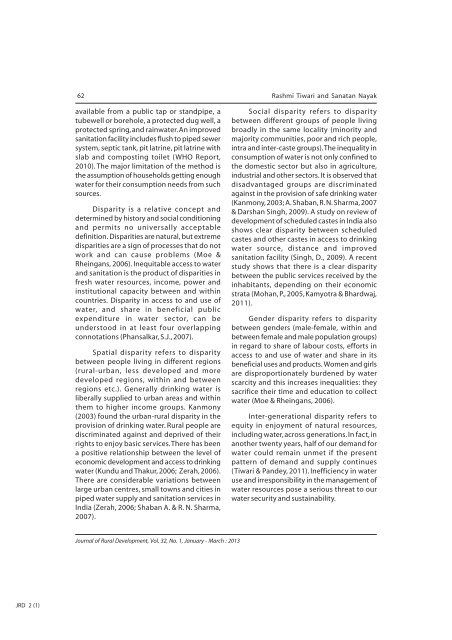January - March 2013 - National Institute of Rural Development
January - March 2013 - National Institute of Rural Development
January - March 2013 - National Institute of Rural Development
- No tags were found...
You also want an ePaper? Increase the reach of your titles
YUMPU automatically turns print PDFs into web optimized ePapers that Google loves.
62 Rashmi Tiwari and Sanatan Nayakavailable from a public tap or standpipe, atubewell or borehole, a protected dug well, aprotected spring, and rainwater. An improvedsanitation facility includes flush to piped sewersystem, septic tank, pit latrine, pit latrine withslab and composting toilet (WHO Report,2010). The major limitation <strong>of</strong> the method isthe assumption <strong>of</strong> households getting enoughwater for their consumption needs from suchsources.Disparity is a relative concept anddetermined by history and social conditioningand permits no universally acceptabledefinition. Disparities are natural, but extremedisparities are a sign <strong>of</strong> processes that do notwork and can cause problems (Moe &Rheingans, 2006). Inequitable access to waterand sanitation is the product <strong>of</strong> disparities infresh water resources, income, power andinstitutional capacity between and withincountries. Disparity in access to and use <strong>of</strong>water, and share in beneficial publicexpenditure in water sector, can beunderstood in at least four overlappingconnotations (Phansalkar, S.J., 2007).Spatial disparity refers to disparitybetween people living in different regions(rural-urban, less developed and moredeveloped regions, within and betweenregions etc.). Generally drinking water isliberally supplied to urban areas and withinthem to higher income groups. Kanmony(2003) found the urban-rural disparity in theprovision <strong>of</strong> drinking water. <strong>Rural</strong> people arediscriminated against and deprived <strong>of</strong> theirrights to enjoy basic services. There has beena positive relationship between the level <strong>of</strong>economic development and access to drinkingwater (Kundu and Thakur, 2006; Zerah, 2006).There are considerable variations betweenlarge urban centres, small towns and cities inpiped water supply and sanitation services inIndia (Zerah, 2006; Shaban A. & R. N. Sharma,2007).Social disparity refers to disparitybetween different groups <strong>of</strong> people livingbroadly in the same locality (minority andmajority communities, poor and rich people,intra and inter-caste groups). The inequality inconsumption <strong>of</strong> water is not only confined tothe domestic sector but also in agriculture,industrial and other sectors. It is observed thatdisadvantaged groups are discriminatedagainst in the provision <strong>of</strong> safe drinking water(Kanmony, 2003; A. Shaban, R. N. Sharma, 2007& Darshan Singh, 2009). A study on review <strong>of</strong>development <strong>of</strong> scheduled castes in India alsoshows clear disparity between scheduledcastes and other castes in access to drinkingwater source, distance and improvedsanitation facility (Singh, D., 2009). A recentstudy shows that there is a clear disparitybetween the public services received by theinhabitants, depending on their economicstrata (Mohan, P., 2005, Kamyotra & Bhardwaj,2011).Gender disparity refers to disparitybetween genders (male-female, within andbetween female and male population groups)in regard to share <strong>of</strong> labour costs, efforts inaccess to and use <strong>of</strong> water and share in itsbeneficial uses and products. Women and girlsare disproportionately burdened by waterscarcity and this increases inequalities: theysacrifice their time and education to collectwater (Moe & Rheingans, 2006).Inter-generational disparity refers toequity in enjoyment <strong>of</strong> natural resources,including water, across generations. In fact, inanother twenty years, half <strong>of</strong> our demand forwater could remain unmet if the presentpattern <strong>of</strong> demand and supply continues(Tiwari & Pandey, 2011). Inefficiency in wateruse and irresponsibility in the management <strong>of</strong>water resources pose a serious threat to ourwater security and sustainability.Journal <strong>of</strong> <strong>Rural</strong> <strong>Development</strong>, Vol. 32, No. 1, <strong>January</strong> - <strong>March</strong> : <strong>2013</strong>JRD 2 (1)
















